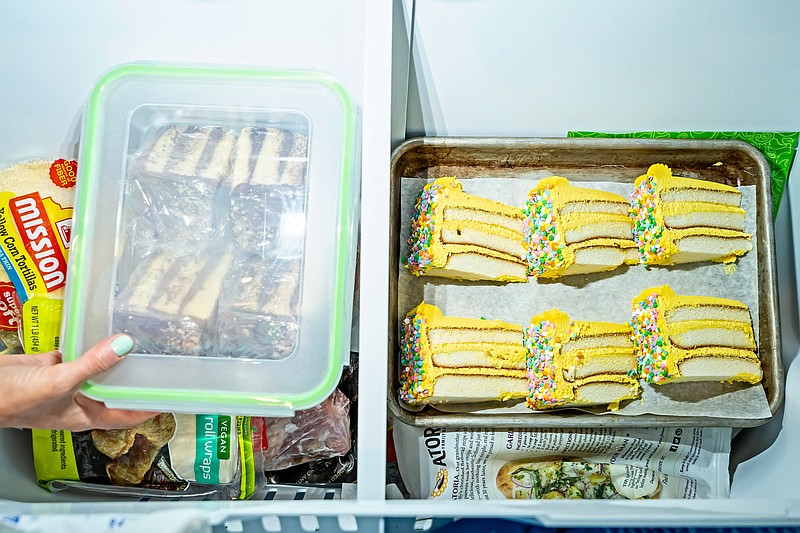I hate to say it, but there is such a thing as too much cake. As a person living alone who dislikes wasting food and sometimes has to bake for work - a rough life, I know - the problem of excess dessert has come up more than once.
With cookies, I can bake off only a couple balls of dough at a time to check if I've gotten the recipe right where I want it to be. When it comes to pies, it's much more likely that I'm able to enjoy the full tin over the course of a few days or up to a week. But when it comes to a standard-size layer or Bundt cake? I can only go so far before the cake is past its prime and I have to call it quits.
But when you're confronted with more cake than your household can consume, there's an easy solution: the freezer.
"Freezing cakes feels like a dirty word to some people, but it is the core of being able to offer quality," cake artist and instructor Penny Stankiewicz says.
Whether unfrosted layers, loafs or Bundts, completely decorated and frosted cakes that have already been cut into slices, or anything in between, the steps are all basically the same: Cool the cake completely, wrap it tightly in plastic wrap and pop it in the freezer.
I'm focusing on cakes that have been fully assembled. Here's what you need to know so you can bake your cake and eat it (all), too.
Not all cakes are created equal when it comes to suitability for freezing. Austin, Texas-based pastry chef and restaurant owner Tavel Bristol-Joseph says that cakes high in moisture and fat are best suited for a trip to the freezer and back, such as carrot cake and Caribbean black cake in particular. Pound cakes and standard layer cakes work well, too. Freezing lighter angel food cake can be more risky, as it could become too dry. But if it's only for a short period of time, such as a week or so, Stankiewicz doesn't think that quality will deteriorate too much.
There's also some debate when it comes to curds often used as fillings. Bristol-Joseph says that they are OK to freeze, but Stankiewicz says it's "not going to come back very nicely" once defrosted. The two agree that it's probably not a good idea to freeze ganache. The first issue is appearance, as any moisture chocolate comes into contact with in the freezer could lead to discoloration. And the second is texture: Once frozen, ganache will "never go back to that super soft suppleness," Stankiewicz says. "At the end of the day, it's still going to be delicious, but it's not going to have that creaminess and that deliciousness that it had on the first go."
In terms of frostings, Bristol-Joseph says that cream cheese is the best for freezing because it expands and contracts along with the cake through the freezing and defrosting process. Another perk of cream cheese frosting: When freezing and defrosting a whole cake or cake tier, any dints, dings and other damage can easily be repaired with a heated spatula. Buttercreams - American or meringue-based - buttercreams are also well-suited for freezing, though Bristol-Joseph notes that any blemishes aren't as seamlessly fixed. But butter freezes more solidly than cream cheese, making frozen buttercream less fragile to begin with. Lower down the list are fondant and royal icing, because cracks in fondant are harder to hide and royal icing will take on the color of whatever it touches. According to Stankiewicz, the one frosting that you want to completely stay away from is seven-minute frosting.
One more consideration is fresh fruit. Berries in particular will have a dramatically different texture after freezing and defrosting and will release a lot of their moisture into the cake. This could lead to a tasty, satisfying result, but it could also go in the other direction.
For the best results, timing is also crucial. "Get it into the freezer as soon as you know you're not going to eat it all," Stankiewicz says. "The less time it spends at room temperature, the better it will be when you are ready to eat it."
Whether individual slices (my personal fave), partial or whole cakes, the first step is firming up the frosting in the freezer (the fridge also works), uncovered, for an hour or two. (For slices, arrange them on a baking sheet lined with parchment.) Once solid, "You want to wrap the cake as tightly as possible in plastic wrap," Stankiewicz says.
While we on The Washington Post Food team try to be as environmentally conscious as possible, plastic wrap is the item you want to use in this instance. "Freezers have processes where they are removing that humidity from the environment. So if the product isn't properly wrapped, it's going to be removing that moisture from your product, too," Stankiewicz says. She says the cake should be double-wrapped at minimum.
Next, put the plastic-wrapped cake in an airtight plastic container for long-term storage, which helps protect against odors, getting smushed under the quart of soup you forgot about, and condensation when it comes time to defrost. "Cakes are typically sponges, and they will take on the scent of anything in your freezer," Bristol-Joseph says. "You can always forgive a cake that has a little chip or is a little deformed, but you can't forgive a cake that tastes like the freezer."
"For best taste and texture, don't freeze cakes for longer than 3 months," the blog Sally's Baking Addiction says. "You could stretch it to 4 or 5 months, but the sooner you serve it, the fresher it tastes."
When it comes time to eat, the recommendation is to let it completely defrost in the refrigerator before letting it come to room temperature.

